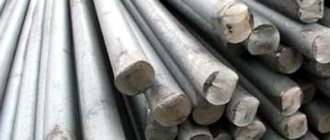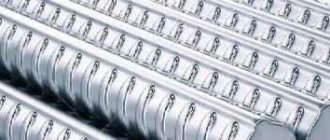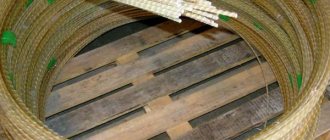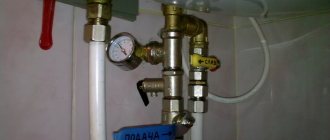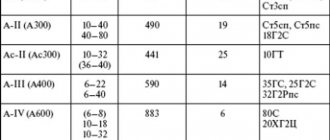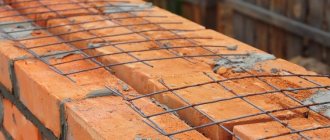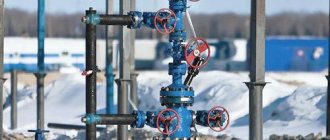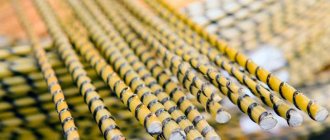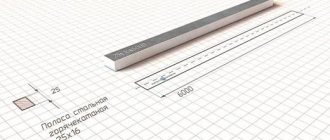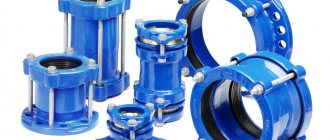SHARE ON SOCIAL NETWORKS
FacebookTwitterOkGoogle+PinterestVk
In the capital construction of monolithic country houses one cannot do without reinforced structures. At the same time, the majority of costs in the process of purchasing materials mainly fall on fittings. The weight of the material, calculated accurately and correctly, will help to realistically estimate not only the costs of organizing construction work, but also an important part of the cost of the entire project.
During construction work, an accurate calculation of the mass of reinforced structures is necessary.
The need to calculate the weight of reinforcement: weight and length correspondence tables
Reinforcement is a building material that is a combination of certain metal elements intended for the construction of a monolithic structure with cement mortar. Serves as a support to retain tensile stress and to strengthen the concrete structure in the compression zone.
Calculating the weight of the reinforcement will help in estimating the cost of construction, as well as the price of the finished object
Reinforcing components are mainly used in the construction of foundations and the construction of walls of concrete monolithic buildings. A significant part of the time, effort and material costs during the construction of a building made of concrete falls on the creation of a reinforced frame, which is made from reinforced rods and meshes. To avoid unnecessary costs, you should calculate the required amount of material as accurately as possible. Here you cannot do without knowledge of the weight of the reinforcement in a meter. A table of weight and length ratios for different types of structures will help you make the correct calculations.
To calculate the weight of the reinforcement, you need to add up the total length of all the rods and multiply it by the mass of one meter. All the necessary data, taking into account the class of steel and the diameter of the rods, is given in the calculation tables. The brand of material from which the reinforcement is made is also taken into account.
Reinforcement weight table: GOST regulating product quality
The weight standard for reinforcement of the corresponding diameter is regulated by developed standards - GOST 5781-82 and GOST R 52544-2006.
A table of the weight of a linear meter of reinforcement, the length and diameter of the rod will help you make the correct calculations:
| Reinforcement cross-section, mm | Weight per linear meter, g | Total length of reinforcement in ton of material, m |
| 6 | 222 | 4505 |
| 8 | 395 | 2532 |
| 10 | 617 | 1620 |
| 12 | 888 | 1126 |
| 14 | 1210 | 826 |
| 16 | 1580 | 633 |
| 18 | 2000 | 500 |
| 20 | 2470 | 405 |
| 22 | 2980 | 336 |
| 25 | 3850 | 260 |
| 28 | 4830 | 207 |
| 32 | 6310 | 158 |
| 36 | 7990 | 125 |
| 40 | 9870 | 101 |
| 45 | 12480 | 80 |
| 50 | 15410 | 65 |
| 55 | 18650 | 54 |
| 60 | 22190 | 45 |
| 70 | 30210 | 33 |
| 80 | 39460 | 25 |
This table is quite easy to use. The first column contains data on the diameter of the bar, the second column contains the weight of a linear meter of a specific type of reinforcing bar. The third column displays the total length of the reinforcement elements in one ton.
The formula for calculating the weight of reinforcement is very simple - the length of the reinforcement multiplied by the weight of a linear meter of reinforcement
Having studied the table, you can notice one pattern. The higher the diameter of the reinforcement, the greater the weight of a meter of material. The total length in one ton, on the contrary, is inversely proportional to the thickness of the rods.
Helpful advice! The diameter size must be obtained from the manufacturer. If you measure it yourself, this will entail errors in the calculations, since the surface of the reinforcing bars has a ribbed structure.
Thus, knowing the weight of the reinforcement according to GOST 5781-82, it is easy to calculate the coefficient of the overall reinforced structure; you can determine the weight of the reinforcement in relation to the required volumes of concrete. Having this data available, it is easy to calculate the total amount of materials that will be required to construct a specific structure - be it a foundation or a monolithic building. The amount of material consumption is calculated per cubic meter of concrete.
Specific gravity of reinforcement: correspondence tables taking into account linear footage
A linear meter of a profile rod is a piece of material one meter long. It can have both a smooth and embossed surface. The mass of the rods, accordingly, regulates their diameter. GOST sets indicators from 6 to 80 millimeters. The material is based on periodic steel.
The higher the diameter of the reinforcement, the greater the weight of a meter of material
The weight of a mesh made of reinforcing wire for plaster, a reinforced frame for a reinforced concrete foundation, a reinforced mesh for brickwork depends on the dimensions of the fabric, the area of the cells and the diameter of the rods in millimeters. Reinforcing steel produced on the domestic market is widely used in construction, has high-quality characteristics, and meets all GOST requirements for rolled metal.
Calculations are performed using the given reinforcement table. The weight of 1 linear meter depends on the external structure of the profile, which can be corrugated or smooth. The presence of ribs and corrugations on the outside provides more reliable adhesion of the rods to the concrete solution. Thus, the concrete structure itself in this case has higher quality characteristics.
Features of the technological process for manufacturing reinforcing steel determine the entire range of reinforcement. According to these indicators, steel can be hot-rolled rod or cold-drawn wire.
The fittings are widely used in construction, have high-quality characteristics, and meet all GOST requirements.
The fittings produced in accordance with GOST 5781-82 are bars with a smooth surface of class A, as well as profiles made of periodic steel of classes from A-II to A-VI. GOST R 52544-2006 are profiles of classes A500C and B500C made of periodic steel, intended for welding. The letter A is used to mark hot-rolled and heat-strengthened reinforcement, the letter B is for cold-deformed material, and the letter C is for welded rolled products.
Material marking, weight of 1 meter: assortment table
If we take the mechanical characteristics of reinforcing steel as a basis, such as strength and weight, then the material is divided into separate assortment classes with corresponding special designations from AI to A-VI. At the same time, the weight of a meter of hot-rolled steel reinforcement does not depend on them.
The correspondence of class, diameter and brand is clearly demonstrated in the table:
| Steel class according to GOST 5781-82 | Rod diameter, mm | Steel class according to GOST R 52544-2006 | Rod diameter, mm | Reinforcement brand |
| A.I. | 6-40 | A240 | 6-40 | St3kp, St3ps, St3sp |
| A-II | 10-40 | A300 | 40-80 | St5sp, St5ps 18G2S |
| Ac-II | 10-32 | Ac300 | 36-40 | 10GT |
| A-III | 6-40 | A400 | 6-22 | 35GS, 25G2S 32G2Rps |
| A-IV | 10-32 | A600 | 6-8 36-40 | 80C 20*2Hz |
| AV | 6-8 and 10-32 | A800 | 36-40 | 23*2G2T |
| A-VI | 10-22 | A1000 | 10-22 | 22*2G2AYU, 22*2G2R, 20*2G2SR |
If we take, for example, reinforcement of class A-III, then it is used to strengthen the foundation of concrete buildings erected in a short time. The mass of the reinforcement in this case is equal to the weight of the entire steel frame, including the foundation, walls and concrete floors, as well as the mass of welded mesh poured with concrete.
The diameter of the reinforcing bar in the range from 8 to 25 mm is considered the most popular profile size in the construction market. All domestic fittings go through quality control stages before reaching metal warehouses, which guarantees their compliance with GOST.
Reinforcing material is divided into assortment classes with special designations from AI to A-VI
Reference! The volume of a steel rod is calculated by multiplying the footage by the geometric area of the circle - 3.14*D*D/4. D is the diameter. The specific gravity of the reinforcement is 7850 kg/m³. If you multiply it by volume, you get a general indicator of the specific gravity of one meter of reinforcement.
Reinforcement cross-sectional area table
| Nominal diameter, mm | Cross-sectional area, cm2 | Weight of 1 meter, theoretical, kg |
| 6 | 0,283 | 0,222 |
| 7 | 0,385 | 0,302 |
| 8 | 0,503 | 0,395 |
| 10 | 0,785 | 0,617 |
| 12 | 1,131 | 0,888 |
| 14 | 1,54 | 1,21 |
| 16 | 2,01 | 1,58 |
| 18 | 2,64 | 2 |
| 20 | 3,14 | 2,47 |
| 22 | 3,80 | 2,98 |
| 25 | 4,91 | 3,85 |
| 28 | 6,16 | 4,83 |
| 32 | 8,04 | 6,31 |
| 36 | 10,18 | 7,99 |
| 40 | 12,58 | 9,87 |
| 45 | 15,90 | 12,48 |
As you can see, selecting reinforcement is not at all difficult if you remember your school geometry course. Using special reference books on cross-sectional area, you can find out many other important parameters that will allow you to choose the optimal material for building your dream house and constructing any other object.
Reinforcement: weight and various options for calculating it
The weight of reinforcement is calculated in different ways:
- according to standard weight data;
- taking specific gravity as a basis;
- using an online calculator.
The required number of rods according to the standard weight is determined using the above weight table in relation to the linear meter. This is the simplest calculation option. For example, let’s calculate the weight of reinforcement 14.
How much a meter of reinforcement weighs is something both designers and builders of buildings and structures made of reinforced concrete need to know.
The main condition for carrying out such calculations is the presence of an appropriate table. The calculation process itself (when drawing up a construction plan, taking into account the construction of the reinforcing mesh) includes the following stages:
- select the appropriate diameter of the rods;
- calculate the footage of the required reinforcement;
- multiply the weight of one meter of reinforcement of the corresponding diameter by the number of rods required.
For example, for construction it is expected to use 2300 meters of reinforcement 14. The weight of 1 meter of rods is 1.21 kg. We carry out the calculation: 2300 * 1.21 = 2783 kilograms. Thus, to complete this volume of work, 2 tons 783 kilograms of steel rods will be required. The number of rods of the corresponding diameter in one ton is calculated similarly. The data is taken from the table.
Calculations based on specific gravity using the example of calculating the weight of a meter of reinforcement 12
The method of calculating specific gravity requires special skills and knowledge. It is based on a formula for determining mass using quantities such as the volume of an object and its specific gravity. This is the most complex and time-consuming option for calculating weight. It is applicable only in cases where there is no table with standards available and the possibility of using an online calculator is excluded.
When independently calculating the volume of reinforcement, you need to take into account the fact that the rod has a cylindrical shape
These calculations can be clearly seen using the example of determining the weight of 1 meter of 12 mm reinforcement. First, you need to remember the formula for calculating weight from the physics course, according to which mass is equal to the volume of an object multiplied by its density, that is, specific gravity. For steel, this figure corresponds to 7850 kg/m³.
The volume is determined independently, taking into account the fact that the reinforcement bar has a cylindrical shape. In this case, knowledge of geometry will come in handy. The formula says: the volume of a cylinder is calculated by multiplying the cross-sectional area by the height of the figure. The cross section of a cylinder is a circle. Its area is calculated using another formula, where the constant number Pi with a value of 3.14 is multiplied by the radius squared. Radius is, as you know, half the diameter.
The procedure for calculating the weight of reinforcement 12 mm per meter, the length of the entire rod
The diameter of the reinforcing bars is taken from the construction plans and calculations. It is better not to measure it yourself to avoid errors. We determine how much one meter of 12 mm reinforcement weighs. Thus, we find that the radius is 6 mm or 0.006 m.
If it is necessary to calculate the mass of a specific reinforcement bar, then the area of the circle is multiplied by its length
Helpful advice! The easiest way to calculate is to use special programs (or an online calculator). To do this, enter into certain cells the given weight of the reinforcement in tons, the number of the corresponding profile and the length of the rod in millimeters. The standard length of the rods is 6000 or 12000 mm.
The sequence of independent calculations using the formula is as follows:
- Determination of the area of a circle: 3.14*0.006²=0.00011304 m².
- Calculation of the volume of a meter of rods: 0.00011304*1=0.00011304 m³.
- Calculation of the weight of reinforcement 12 in 1 meter: 0.00011304 m³*7850 kg/m³=0.887 kg.
If the obtained result is checked against the table, we will find that the data corresponds to state standards. If it is necessary to calculate the mass of a particular rod, then the area of the circle is multiplied by its length. In general, the calculation algorithm is similar.
The complete procedure for calculating the weight of 1 meter of reinforcement 12, represented by a mathematical expression, will look like this:
1m*(3.14*0.012m*0.012m/4)*7850kg/m³=0.887 kg.
To independently calculate the weight of reinforcement 12 mm per meter, you need to use a certain formula
The result is identical to the previous one. Depending on the length of the reinforcement, the corresponding value is substituted into the formula and the weight is calculated from it. The weight of the entire mesh can be calculated by multiplying the value obtained for 1 m² by the required number of square meters in the reinforced frame.
Calculation of the weight of reinforcing wire per square meter
The reinforcing wire meets the requirements of GOST 6727-80. Low carbon steel is used for its production. The diametral values of ordinary wire are 3, 4 and 5 mm. The assortment has two classes: BI - with a smooth surface and VR-1 - material from a periodic profile.
Related article:
I-beam: size table, weight and technical characteristics of profiles
Product design features. Formulas for calculating I-beams. Price per linear meter of I-beam profile.
The weight of the wire is calculated in accordance with special standards and data given in the table:
| Wire diameter, mm | Weight of one meter, g |
| 3 | 52 |
| 4 | 92 |
| 5 | 144 |
You can calculate the weight for a specific case using the following algorithm. In order to determine the mass of one hundred meters of reinforcing wire with a diameter of 4 mm, it is necessary to multiply the specific gravity by the footage. The calculation will look like this:
92*100 = 9200 g (or 9 kg 200 g).
The reverse calculation can also be done. For example, a coil of wire with a diameter of 4 mm weighs 10 kg. To determine the footage, you need to divide the total mass by the specific gravity. The calculation looks like this: 10/0.092 = 108.69 meters.
Low carbon steel is used to produce reinforcing wire
The following methods are used to calculate the weight of the reinforcing mesh. For example, the grid dimensions are 50x50x4. The square meter area includes 18 rods of 1 m each. Thus, a total of 18 m of reinforcement 6 is obtained, the weight of which is 0.222 kg/m. The linear meter of wire in the structure is calculated as follows: 18*0.222=3.996 kg/m². Approximately 1% should be added to account for welding errors. We'll get a full 4 kilograms.
Related Posts via Categories
- How to calculate the cross-sectional area of reinforcement of all types?
- How much does 1 meter of construction rod reinforcement of various types weigh?
- Length of rod reinforcement - all possible options regulated by GOSTs
- Linear fittings – high-quality installation of power lines is guaranteed!
- Unmeasured reinforcement is the best option for low-rise construction!
- Brands and classes of construction rod reinforcement and wire for reinforcement
- Coupling fittings, what they are and what they are used for
- Anchoring reinforcement in concrete is a complex but important operation
- Hot-rolled reinforcement - GOST and the entire life cycle of the product
- Weight and features of steel corrugated reinforcement A3 and other classes
How to find out the weight per meter of reinforcement with a diameter of 8 mm
Characteristics, dimensions and calculation of the weight of reinforcement 8 mm per meter
Reinforcing bars with a diameter of 8 mm are considered thin. At first glance, they resemble simple wire. The technological process of their manufacture is regulated by GOST 5781. The surface of the reinforcement 8 can be corrugated or smooth.
Helpful advice! In any calculations and calculations of the mass of reinforcement, one should not forget about the permissible error readings. They range from 1 to 6%. This is especially important to consider when large volumes of welding work are expected.
The main technical characteristics of the material are as follows:
- for production they use steel marked 25G2S and 35GS;
Reinforcing bars with a diameter of 8 mm are considered the thinnest and resemble ordinary wire
- ribbed pitch - A400 and A500;
- reinforcement class A3.
A rod weight of 8 mm per meter is most appropriate in places where excess weight is unacceptable, but additional strength is required. The weight of 1 meter of reinforcement 8 is 394.6 grams. In a ton, the amount of material will be 2,534.2 m.
The weight of 1 meter of 8 mm reinforcement is calculated using the above formula using the specific gravity of the corresponding steel:
1m*(3.14*0.008m*0.008m/4)*7850kg/m3=0.394 kg. This is the value of the weight of reinforcement 8 that is given in the table of correspondence between weight and length of reinforcement.
Connecting rods by welding
Overlapping of rods by welding is used exclusively with reinforcement grades A400C and A500C.
Only these grades are considered weldable. This also affects the cost of products, which is higher than usual. One of the common classes is class A400. But merging products with them is unacceptable. As the material heats up, it becomes less durable and loses its resistance to corrosion. In places where there is overlap of reinforcement, welding is prohibited, regardless of the class of the rods. Why? If you believe foreign sources, there is a high probability of the connection breaking if it is subjected to heavy loads. As for Russian rules, the opinion is as follows: using electric arc welding for joining is allowed if the diameter size does not exceed 25 mm.
Scope of application and calculation of the weight of reinforcement 10 mm per meter
One of the most popular in construction is a rod with a diameter of 10 millimeters. Such reinforcement, like rods of other thicknesses, is produced by hot-rolled or cold-rolled methods. These are metal rods of medium thickness with a high degree of strength.
10 mm reinforcement is used to create lightweight buildings: private houses, garages, where strip foundation pouring is used
Calculating the total weight of reinforcement 10 is quite simple: just sum up the total length and multiply it by the mass of a linear meter of material. The necessary data can be found in the general table.
The general characteristics of fittings 10 are as follows:
- rod diameter – 10 mm;
- there are 1622 m of rolled products in one ton;
- weight of 1 meter of 10 mm reinforcement – 616.5 g;
- the permissible error when calculating weight is +6%;
- steel classes used in the production of this type of rolled metal: At-400, At-500S, At-600, At-600K, At-800K, At-1000, At-1000K, At-1200.
With the given parameters, you can easily find out the required quantity and weight of building material. It’s quite easy to do an independent calculation using the formula you’ve already written; it will look like this:
1m*(3.14*0.01m*0.01m/4)*7850 kg/m³=0.617 kg. A similar indicator of the weight of 1 meter of reinforcement 10 is contained in the table of the ratio of diameter and weight of one meter.
10 mm reinforcement is classified as an easily processed material, since the rod is easily bent or subjected to any other necessary deformation
Docking reinforcement using the knitting method
This is the easiest way to ensure a reliable rebar structure. For this work, the most popular class of rods is used, namely A400 AIII. The overlapping reinforcement connection without welding is performed using a binding wire. To do this, two rods are placed next to each other and tied in several places with wire. As mentioned above, according to SNiP, there are 3 options for fixing reinforcing bars with viscous. Fixation with straight ends of a periodic profile, fixation with straight ends of the transverse type, and also using parts with bends at the ends.
It is absolutely impossible to connect reinforcement bars with an overlap. There are a number of requirements for these connections so that they do not become the weak point of the entire structure. And it’s not just about the length of the overlap, but also other points.
Important nuances and requirements for viscous connections
Although the process of connecting rods using wire is simpler than connecting them with a welding machine, it cannot be called simple. Like any work, the process requires strict adherence to rules and recommendations. Only then can we say that the reinforcement of the monolithic structure is done correctly
When connecting reinforcement with an overlap using the knitting method, you should pay attention to the following parameters:
- rod cover length;
- location of the connection point in the structure and its features;
- how the overlaps are located one to the other.
We mentioned that it is impossible to place an overlapping reinforcement joint in an area with the highest degree of load and stress. These areas also include the corners of the building. It turns out that you need to correctly calculate the joints. Their location should be in areas of the reinforced concrete structure where there is no load, or where it is minimal. What to do if it is technically impossible to comply with this requirement? In this case, the size of the overlap of the rods depends on how many diameters the reinforcement has. The formula is as follows: the size of the connection is equal to 90 diameters of the rods used. For example, if Ø20 mm reinforcement is used, then the overlap size in the area with high load is 1800 mm.
However, technical standards clearly regulate the dimensions of such connections. The overlap depends not only on the diameter of the rods, but also on other criteria:
- class of fittings used for work;
- what grade of concrete is used for pouring concrete;
- what is a reinforced concrete base used for?
- degree of load applied.
Versatile features and ideal reinforcement weight 12
Reinforcement with a diameter of 12 mm is rightfully considered the most popular in the metal rolling industry and the most in demand. Its dimensions are the most optimal for various types of construction work. This reinforcement amazingly combines such qualities as strength, flexibility and fairly low weight. At the same time, it has a high degree of adhesion to concrete. Reinforcement frames and structures using it last for a very long time. They are practically indestructible. It is reinforcement 12 that is recommended by construction standards for the construction of strip foundations for cottages and private houses.
Characteristics of fittings 12:
- rod diameter – 12 mm;
- there are 1126 m of rolled products in one ton;
- rod ovality – no more than 1.2 mm;
- pitch of transverse projections – from 0.55 to 0.75* dH;
- the weight of 1 meter is 887.8 g;
- rolled length – from 6 to 12 m.
Tolerance is possible only in a larger direction and no more than 10 cm, and the curvature should not exceed 0.6%.
Reinforcement with a diameter of 12 mm is considered the most popular and in demand in the construction industry
Important! Each type of reinforcement has its own characteristics, and a large diameter does not necessarily guarantee good strength. The same applies to weight. Reinforcement 20, for example, is more vulnerable to corrosion, but is ideal for welding. Therefore, the choice of material is individual.
It was on reinforcement 12 that an example of calculating the weight of a linear meter of a product was considered. The calculations carried out coincided with the data in the table for the weight of reinforcement per meter of 12 mm . This figure in all cases was 887.8 g.
Options for reinforcing right angles and joints
Rebar weight calculator
The corner elements of the strip foundation experience the greatest loads after the building is erected. Therefore, the reliability and durability of the entire structure will depend on how well the reinforcement of these sections of the foundation is done. Simple knitting of longitudinal reinforcement elements at right angles is unacceptable, since this method does not provide additional strength. There are three main methods of reinforcing corner parts and junctions for strip foundations:
First way
The main external longitudinal reinforcement is bent at 90 degrees. The internal longitudinal bars are also bent at 90 degrees and attached with wire to the external longitudinal bars. The size of the bent part of the internal rods should be equal to 50 diameters of the longitudinal reinforcement. The same operations must be carried out at all horizontal levels of the reinforcing frame.
The pitch of vertical (transverse) reinforcement in corner elements and joints should be 0.5 of the main pitch. The same step requirement applies to all other methods of reinforcing corner parts and junctions.
Second way
This method of anchoring at corner joints and junctions for the manufacture of a metal frame is considered the simplest and is often used. If the length of the longitudinal rods is not enough to bend them, L-shaped fastening elements are used. The length of each arm of such elements must be at least 50 diameters of the main reinforcement. The external longitudinal rods are connected by one L-shaped element to each other. Each internal longitudinal element is connected to an external reinforcement bar using an L-shaped element. To reinforce one corner connection, three L-shaped clamps will be required for each longitudinal level of the frame. For the junction, two such elements are required for each level.
Third way
To make the metal reinforcing frame more durable, we install U-shaped elements in the corners and joints. The width of such elements corresponds to the width of the reinforcing frame, and the length is at least 50 diameters of the longitudinal reinforcing bar. These elements are knitted to the main longitudinal rods with the open part of the letter “P” in the direction from the corner. To reinforce one corner, two such elements are required (at each horizontal level), for the junction, one element at each level.
Composite reinforcement
Composite reinforcement is a modern alternative to steel analogues, which have long been used in monolithic construction. Its development began back in the 60s of the last century. In Russia it is produced in accordance with the requirements of GOST 31938-2012. In other countries, the international standard ISO 10406-1:2008 is used as a basis.
Classification of composite reinforcement
The starting materials for the production of composite reinforcement are carbon, glass, and fibers based on natural minerals. They form a strong rod, which is given a ribbed shape in various ways. Parts acquire strength and hardness as a result of high-temperature treatment.
Based on material design, non-metallic fittings are divided into several categories:
1. Fiberglass composite reinforcement (FFR) is a product of a combination of fiberglass (glass roving) with special resins. The fibers are obtained by drawing a molten aluminoborsilicate mixture to a thickness of about 10-20 microns. They are used to form rods of larger diameter using adhesive impregnations and resins.
ASK fittings.
2. Basalt-composite reinforcement (BCR) is obtained from molten mountain mineral - basalt. It is brought to a molten state, stretched to the state of the finest fibers. They are woven in the presence of organic resins into fairly thick rods that, when hardened, can withstand extreme loads.
ABK fittings.
3. Combined composite reinforcement (AKK) consists of fiberglass rods coated on the outside with basalt-plastic winding. It is somewhat inferior in strength characteristics to basalt rods, although it is often passed off as them by unscrupulous suppliers.
ACC fittings.
4. Carbon composite reinforcement (ACF) is made from carbon fibers 3-15 microns thick, laid parallel to each other. This material has very high tensile strength, but is more expensive than other composite analogues.
5. Aramidocomposite rods (AAC) are durable and chemically resistant parts made from polyamide molecular chains. The hydrogen bonds that arise between them during the molding process give the products special reliability and durability.
Dimensions of composite reinforcement
Composite reinforcement, even with a small thickness, can take on enormous loads. The most popular diameters of such rods are presented in Table No. 4.
Table 4. Nominal diameters of composite reinforcement
| Nominal diameter according to GOST 31938-2012 Composite polymer reinforcement for reinforcing concrete structures. General technical conditions (with Amendment), mm | ||||||||||||
| 4 | 6 | 8 | 10 | 12 | 14 | 16 | 18 | 20 | 22 | 25 | 28 | 32 |
The standard allows the production of composite reinforcement with other sizes. The rods usually arrive from the manufacturer in a strictly defined cut. Their length ranges from 0.5 to 12.0 meters. Maximum deviations in the length of single copies cannot exceed the values specified in table No. 5.
Table 5. Requirements for the manufacturing accuracy of composite rods
| Rod length | Maximum deviations along the length, mm |
| up to 6 meters inclusive | +/- 25 |
| over 6 to 12 meters | +/- 35 |
| more than 12 meters | +/- 50 |
Some types of composite rebar come in the form of coils or wound on rigid drums.
Coil of composite reinforcement.
Profile type
Composite reinforcement cannot be made completely smooth. For better contact with the concrete mixture, it is given a relief profile.
He can be:
1. Conditionally smooth. The main fiberglass rod of constant cross-section is covered with a topping of fine-grained quartz sand firmly bound to the base.
Fiberglass reinforcement with sand coating.
2. Periodic. A fiberglass strand is tightly wound around the central rod, giving the surface a regular helical structure.
Composite reinforcement with periodic corrugation.
Overview of species
Reinforcement of any of the above diameters is made from low-carbon steel. Just enough carbon is mixed with iron so that the frame, welded from sections of such reinforcement, can withstand significant loads for a number of decades without changing its properties, and when processed at the construction stage of the building, it bends as intended by the design.
By manufacturing method
To improve the properties of simple rusting steel, small amounts of manganese, titanium, silicon and chromium are added to the alloy. These additives adjust the properties of the steel from which the reinforcement is cast in conditions of high humidity and harsh climates. According to the manufacturing method, the fittings are produced in 3 types:
- hot rolled;
- heat resistant;
- cold drawn.
The second type is subjected to hardening immediately after production, the third is drawn in a cooled state after leaving the conveyor.
By strength class
The designation of construction rolled ferrous metal determines its class.
- Classes A1 and A2 are used for reinforcement tightening. Transverse, thinner reinforcement can also be used smooth, without corrugation. This steel is the most elastic. Class A2 is slightly denser than A1.
- A3 – balance between average (optimal) strength and price for metal supplies. It is used to build walls of residential (apartment) buildings and is the main support.
- A4 is used for multi-story construction, including the use of reinforced concrete products from prefabricated structures. It is not recommended to weld this steel - it is preferable to bandage it, since the welded joint may burst inside the concrete.
- Classes A5 and A6 are the most expensive, but the most durable. They are used in industrial construction, in the construction of spans and arches of bridges.
Special
Special fittings include connecting parts of different designs that play an auxiliary role, as well as rope and prestressed fittings. The latter bends or bends, is additionally compressed or stretched before pouring concrete - stressed reinforced concrete is formed. Rope reinforcement includes a steel cable of special strength, around which concrete is poured.
